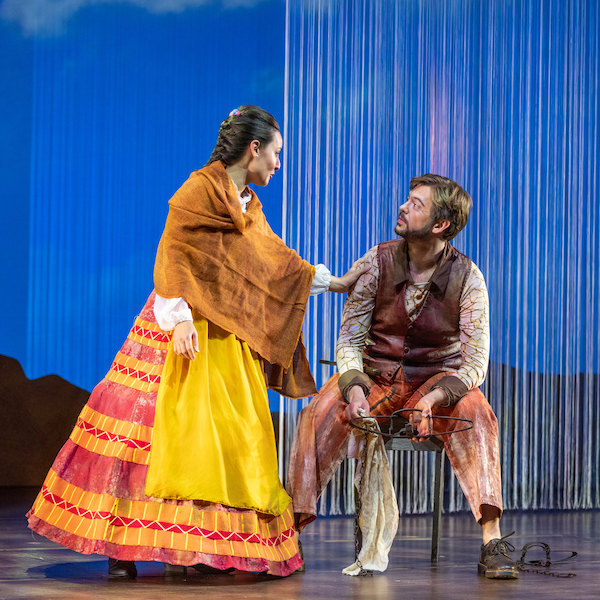Opera Lafayette revives a Grétry comic opera, with a charming American twist

Camille Ortiz (Hélène) and Victor Sicard in the title role of André Grétry’s Silvain, presented by Opera Lafayette. Photo: Jen Packard
Opera Lafayette last performed a complete opera by André Grétry in 2011, with Le Magnifique. The period instrument ensemble has returned to the Belgian-born French composer’s oeuvre with a colorful staging of his one-act opéra comique Silvain, in the work’s modern premiere. Thursday’s performance at the Kennedy Center Terrace Theater, although sparsely attended, reinforced the notion that Grétry’s music has been unjustly forgotten.
Silvain, premiered in 1770 at the Comédie-Italienne, was one of Marie-Antoinette’s favorites, which fit nicely into Opera Lafayette’s season-long focus on the French queen’s era. In addition to some 400 performances in Paris through 1827, the opera was performed almost thirty times in French-held Saint-Domingue, prior to the Haitian revolution. Many musicians from Saint-Domingue fled to New Orleans, where Silvain also became the first opera known to be performed in that city.
The title character in Jean-François Marmontel’s libretto is a noble’s son, disinherited by his father because he has married a local peasant. Silvain and Hélène live as simple farmers, raising their two daughters, Pauline and Lucette, in rustic peace. On the day of the elder daughter’s wedding, to the son of a neighboring farmer, Silvain is charged with violating poaching laws by the son of the new local lord, who turns out to be Silvain’s estranged father. Wife and daughters charm the new landowner in Silvain’s favor, and all is forgiven.
Film director Tania Hernández Velasco transposed the action from 18th-century rural France to 19th-century New Mexico. The setting was based on historical research into the life of Charles H. Beaubien, a Quebecois farmer and trapper who settled in Taos, New Mexico, in 1824. A new version of the spoken dialogue, by Linn Cary Mehta, mingled Spanish, French, and English to recontextualize the musical numbers, sung in the original French.
French baritone Victor Sicard led a fine and youthful cast, with vocal power and refinement in a sympathetic portrayal of Silvain. The singer who created the role, Joseph Caillot, was described as “a baritenor and a bass at the same time,” and Sicard deployed his considerable ambitus from easy top notes down to a robust lower range.
As Hélène, Camille Ortiz’s intense soprano rang out with dignity and beauty, making “Il va venir, je dois l’attendre,” the character’s unusual accompanied recitative sung as she awaits the first encounter with her father-in-law, into a dramatic tour de force. Just before that scene, she and Sicard melded their voices amiably in their extensive duet, “Dans le sein d’un père,” complemented by plangent oboe solos from Margaret Owens.
The flirtatious Lucette of soprano Teresa Castillo injected some much-needed energy into the opening of the opera. Her high notes sizzled with energy, and her teasing interactions with her sister provided welcome comic relief. Samantha Louis-Jean’s darker-hued soprano made a brilliant foil as Pauline, with the contrast of the two voices making them easy to distinguish in ensembles together.
The light-toned tenor of Jehú Otero suited the earnest role of Bazile, Pauline’s sweet-hearted fiancé. From the moment of his entrance aria, “Tout le village me l’envie,” where he was heard offstage at first, his dulcet high notes and clean tone impressed, accompanied pertly by the piccolo (“pettite flute”) playing of Charles Brink. Otero and Louis-Jean made a charming vocal pair in their duet, which Otero recalled later by playing a part of it on a guitar, in a pleasing unscripted moment.
Rounding out the cast was the potent menace of Canadian bass-baritone Nathan Berg as Silvain’s forbidding father, whose heart is melted by the family he longs to join. The three guards (Juan Hernandez, Gilbert Chavez, and Jose M. Pietri-Coimbre) made a strong, foot-stamping impression as they tried to arrest Silvain, in the opera’s largest ensemble. Their tendency to rush ahead of the beat required some finessing by conductor Ryan Brown.
Colorful dresses for the women evoked the Mexican origins of Hélène’s family (costumes designed by Patricia Michaels). Video projections changed the scene from interior to exterior, the stage space hung with veils of hanging cords (set and projection design by Josh Higgason), with A.J. Guban’s lighting creating an especially striking vista in Hélène’s solo scene.
Brown presided over a confident orchestra in the Terrace Theater’s small pit, with the full complement of winds and horns called for in the score playing softly to match the limited numbers of strings (8 violins, 2 violas, 3 cellos, and 1 bass). As Grétry made clear in his diverting Mémoires, ou essai sur la musique, his focus was always on the melodic charm of the vocal line rather than on harmonic complexity or orchestration.
To impress upon his reader the care he took with the natural declamation of his sung lines, Grétry wrote of his pre-premiere revisions to the duet “Dans le sein d’un père.” Mlle Clairon, who created the role of Hélène, thought some passages were not good. Grétry had her declaim the lines as she preferred, taking down her inflection like a melodic dictation. He even made a few corrections to the vocal lines from how they were rendered in the printed score.
Silvain will be repeated 7:30 p.m. June 3 at the Kennedy Center and 7 p.m. June 7 at the Museo del Barrio in New York. operalafayette.org
